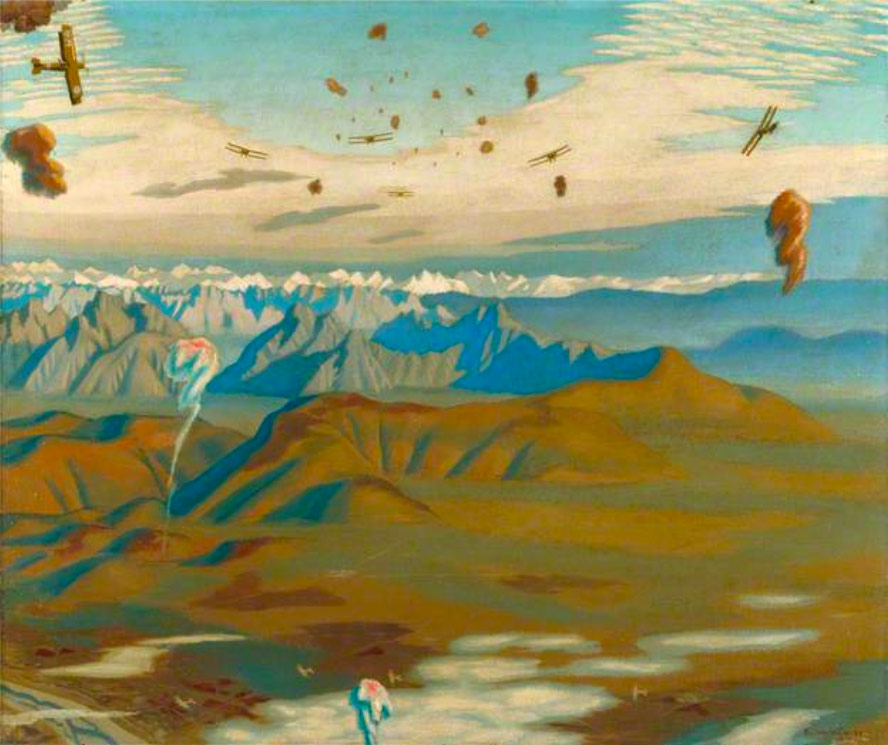In conjunction with the Exhibition WAR IN THE SUNSHINE: THE BRITISH IN ITALY 1917-18
A guided tour and talk by Dr Jonathan Black, Curator
The Estorick Collection, one of the world’s greatest collections of 20th Century Italian art, has reopened after extensive refurbishment with a major exhibition of paintings and photographs, which were rediscovered by Jonathan Black in the archives of the Imperial War Museum. The images by official British war artists and photographers highlight a forgotten aspect of Britain’s involvement in the Austro-Italian conflict during World War 1. With shimmering Alpine landscapes and intimate portraits of Italian peasant women, the images show the powerful impact Italy, and the Veneto, made on the artists and on the British troops fighting there. The exhibition has received outstanding reviews.
Sydney Carline (1888-1929) was born in north London into a highly artistic family – both his parents were accomplished painters. Sydney displayed a precocious talent for working in watercolour while studying at Repton School and at the Slade School of Art. He emerged as a talented landscape artist, a gifted topographical etcher and a skilled designer of medals. Deeply torn as to whether he should volunteer for war service – his family was inclined to pacifism – Sydney finally volunteered in 1916 to become a pilot with the Royal Flying Corps, and was posted to a fighter-bomber squadron in France. He was shot down and seriously wounded on his third mission, and had to spend nearly a year recuperating. In February 1918 he was posted to a Sopwith Camel Squadron based near Vicenza. This was part of the British Expeditionary Force to Italy, which had arrived in the Veneto in November 1917. Sydney served as a fighter pilot for five months, during which he shot down three Austro-Hungarian aircraft and twice crashed after being hit by anti-aircraft fire. In July 1918 he was appointed as an official British war artist with a brief to record the exploits of the RAF squadrons based in Italy. He sketched from the cockpit of his Sopwith Camel and from the rear cockpit of a Bristol fighter-bomber. He also drove over the battlefields of the Piave and the Asiago Plateau in 1918 in his motorcycle and sidecar.
Dr Jonathan Black will give a guided tour and a talk on Carline’s works in the exhibition, focusing on the artist’s experiences as a fighter pilot in the Italian skies, his images of dramatic Italian landscapes below, his perception of the Italian people (as combatants and refugees) and of the Austro-Hungarian enemy, whom the British regarded as a mysterious, unknown quantity. Sydney fell in love with Italy. He took his first post-war holiday in 1920 in central/southern Italy (his father George actually died in Assisi during that trip), and visited Italy almost every year in the 1920’s. He was planning a trip to Tuscany, when he fell ill and died in 1929.
Dr Black is the Curator of, and originally conceived the idea for, this exhibition. He studied History at St John’s College, Cambridge, and History of Art at University College, London. His publications include: The Face of Courage: Eric Kennington, Portraiture and the Second World War (London 2011); Abstraction and Reality: The Sculpture of Ivor Roberts-Jones (with Sara Ayres, London 2013) and The Complete Prints of C R W Nevinson (London 2014). He has also contributed essays to the exhibition catalogue. His next book is The Titan with Many Faces: Winston Churchill in British Art c. 1900 to the Present Day (March 2017).
Dr Black is currently Senior Research Fellow in History of Art at Kingston University focusing on the period 1900 – the 1940’s and particularly on the work of official and informal war artists.
Drinks will be served



